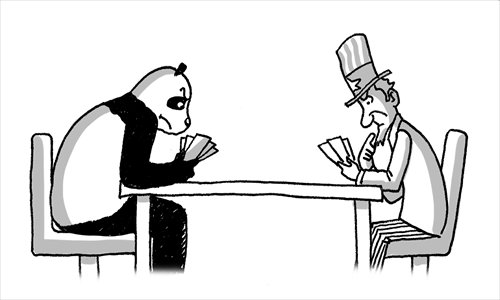


Illustration: Liu Rui/GT
Most analysts consider the Trans-Pacific Partnership (TPP) the centerpiece of the US rebalance to the Asia-Pacific region and a major criterion to measure whether the US can win the strategic competition with China. That's also the way US President Barack Obama and his government view it. It's deeply rooted in Washington's strategic thinking that leadership is built on the power of rule-making.
Even though China's "One Belt, One Road" initiative is not intended to rewrite any rules, it has the ability to do so in the context of the China-US competition. Rules are required for China's investment package and cooperation mechanisms for the initiative. These rules will result in new changes of the regional economic order and forge new trade ties between China and other countries along the "One Belt, One Road."
When it comes to rule-making, the US is more unequivocal than China as it explicitly defines the TPP as the basis for new rules of global trade in the future. A global rule will be established if it can also reach free trade agreement with the EU.
However, a global trade framework can't be stable if China is excluded. That's why China thus far has no serious concerns about the TPP. The US is well aware of China's significance for the partnership but still forges ahead without China, partly because Washington knows that it will be difficult for China to alter the rules if they have been widely accepted by many countries.
More importantly, the US understands that the formation of a free trade organization, particularly one like the TPP that spans the Pacific, may eventually reconfigure the global value chain.
All the free trade agreements, bilateral and multilateral, are exclusive. They may be conducive to promoting global free trade, but deep inside they are mainly designed to protect the cooperation between signatories.
For instance, members of a free trade organization like the TPP have to pay higher cost due to tariffs if they import products from an outside party. They then tend to buy these products from their fellow members.
If the organization demands its members to follow the rules of origin, the member countries will have to relocate the production lines of some products from nonmember states to their fellows. This has already taken place. Due to the North American Free Trade Agreement, some US businessmen transferred their US-based factories to Mexico instead of China.
Surely China can join the TPP, but the US is unwilling to see this now. If China waits and applies when the TPP is well developed, it will then have to adapt to established rules, as it did upon its accession to the World Trade Organization.
The US has pushed China into a platform where both sides must compete for the establishment of a new global trade order. Whether China likes it or not, the US has made clear its rivalry with China and will likely make some rules specifically directed at China.
Since the competition looks unavoidable, China has to be well prepared and conceive more inclusive trade rules when carrying out its "One Belt One Road" initiative and apply these rules into other programs. For example, China needs to improve its trade rules with ASEAN and make them more applicable to regional cooperation. In addition, it needs to push forward free trade negotiations with Japan and South Korea.
These talks may be difficult, but in the process more specific rules can be formed. This is probably more important than conducting successful negotiations.
The author is a senior editor with People's Daily. He is now stationed in Brazil.
 J-11 fighters in air exercise
J-11 fighters in air exercise Beauties dancing on the rings
Beauties dancing on the rings Attendants-to-be join Mr. & Miss Campus Contest
Attendants-to-be join Mr. & Miss Campus Contest Beijing's toughest anti-smoking law takes effect
Beijing's toughest anti-smoking law takes effect Family lives in cave for about 50 years in SW China
Family lives in cave for about 50 years in SW China PLA soldiers operating vehicle-mounted guns in drill
PLA soldiers operating vehicle-mounted guns in drill Blind carpenter in E China's Jiangxi
Blind carpenter in E China's Jiangxi China hosts overseas disaster relief exercise for the first time
China hosts overseas disaster relief exercise for the first time 20 pairs of twins who will become flight attendants in Sichuan
20 pairs of twins who will become flight attendants in Sichuan Obama is sowing discontent in S.China Sea
Obama is sowing discontent in S.China Sea Rescuers work through night to reach cruise ship survivors
Rescuers work through night to reach cruise ship survivors Driving through limbo
Driving through limbo Facing down MERS
Facing down MERSDay|Week